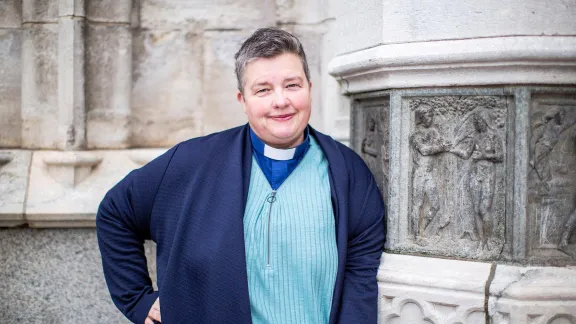
Rev. Charlotte Frycklund serves as the Church of Swedenâs âinternet priest.â Photo by: Argument/Pierre Eriksson
Voices from the Communion: Rev. Charlotte Frycklund
(LWI) - Known as the “internet priest” Rev. Charlotte Frycklund spends her days and evenings on the Church of Sweden’s (CoS) social media accounts, along with the church’s communications team, connecting people to the church, answering simple to complex questions about faith, church and theology, and offering prayers during the unprecedented times of the Coronavirus (COVID-19) pandemic.
Frycklund is the first pastor in the CoS who has the web as her parish. She began this work years before COVID-19 closures forced many churches to use online platforms to reach their congregations.
When did you start as the internet priest?
I started in 2016. It was a continuation of the CoS’s campaign to be personal, relatable and relevant on social media. In some of the conversations people had with the CoS it was deemed that a priest who answered questions about faith and tradition online would be a good idea. The questions ranged from explaining the reason for liturgical clothes to pastoral questions such as the problem of good and evil. Social media is a place where a priest can have an in-depth conversation with seekers of these answers, more so than they would on a Sunday morning.
Who identified this as a possible platform for priests?
It was the people who identified this need. The people online wanted to talk to the church using social media. Initially, when I was first available online it was part time and eventually more people asked for this sort of online access to a priest. The demand for a priest to answer these questions took up more and more time until the church finally decided to hire me full time for this work.
Who is engaging with you online?
I would say that most of the people who engage the CoS on Facebook are 55 and older - slightly more women than men. On Instagram and Twitter, you can’t see gender and age as you can on Facebook, but judging from the conversations, I think the followers are somewhat younger on those platforms.
We tried to connect with an even younger audience, between 13-20 years old by creating an Instagram account just for this age group. That didn’t really fly, because I suspect we did not talk to them in a way they could respond to. Perhaps the person in charge of such an account should be closer to 20 years old than 50.
Have you seen an increase in social media engagement since COVID-19?
Social media for churches has changed a lot since COVID-19 hit. First of all, more parishes are using social media, doing live sessions and gathering their flock on Facebook, which means that more people have found a church home online. Me and the communications team started to do short prayers on Facebook once a week, and this has been a good way to reach out. Although the online devotionals are just three to four minutes long, we noticed that social media followers plan for the online prayers by taking out a candle and maybe a cup of coffee and streaming the Facebook prayer onto larger TV screens. This gives them the feeling of being a part of the worship.
During the pandemic, the questions have indeed changed to worry, anxiety, prayers for the sick and hospital staff, and recently, prayers to handle boredom, as well as prayers of thanksgiving that boredom may be the worst thing they have to endure. We are happy to be a part of the online prayer team during this time of COVID, but also concerned with how people are feeling and coping.
What do you like about being a social media priest?
I love being a part of people’s conversation about the existential questions in life. I love being there in the now, so to speak, not when people find time to sit down and reflect, - which is more the case in parish work - but available directly when trouble hits. People don’t tend to put down their phones when trouble comes or a cause to celebrate arises, they use the devices to reach out. And when they do, the church is there, in the middle of the crisis or joy, and I get to be there directly. I value that.
What would you like to see more of in online ministry?
I would like to be part of a global community of online priests and pastors. It is a wonderful calling to be a priest on social media, but sometimes I wish I had peers in the same position for fellowship, learning and conversation.
What tips can you give churches as they continue their online ministries?
Being online as a church, even outside of a pandemic, is a good thing. It makes it easier for people to attend and feel engaged. Some of my colleagues have noted that attendance is much higher at virtual worship, than in our in-person services, so that is something we need to continue to minister to - the people who want to be part of the church service but cannot make it to the building. Continue online prayer! Find out what your parish wants and needs and stay present on Facebook, Instagram, TikTok or wherever to provide that need for them.
What does it mean for your church, your work, and you to be a part of the communion of churches?
As global Lutherans, we do not see each other every day in person, but we can on social media, and that is where we can know that we are part of each other's prayers, part of a communion of churches.
LWF/A.Gray
The Lutheran World Federation is a global body that shares the work and love of Christ in the world. In this series, we profile church leaders and staff as they discuss topical issues and set out ideas for building peace and justice in the world, ensuring the churches and communion grow in witness and strength.


